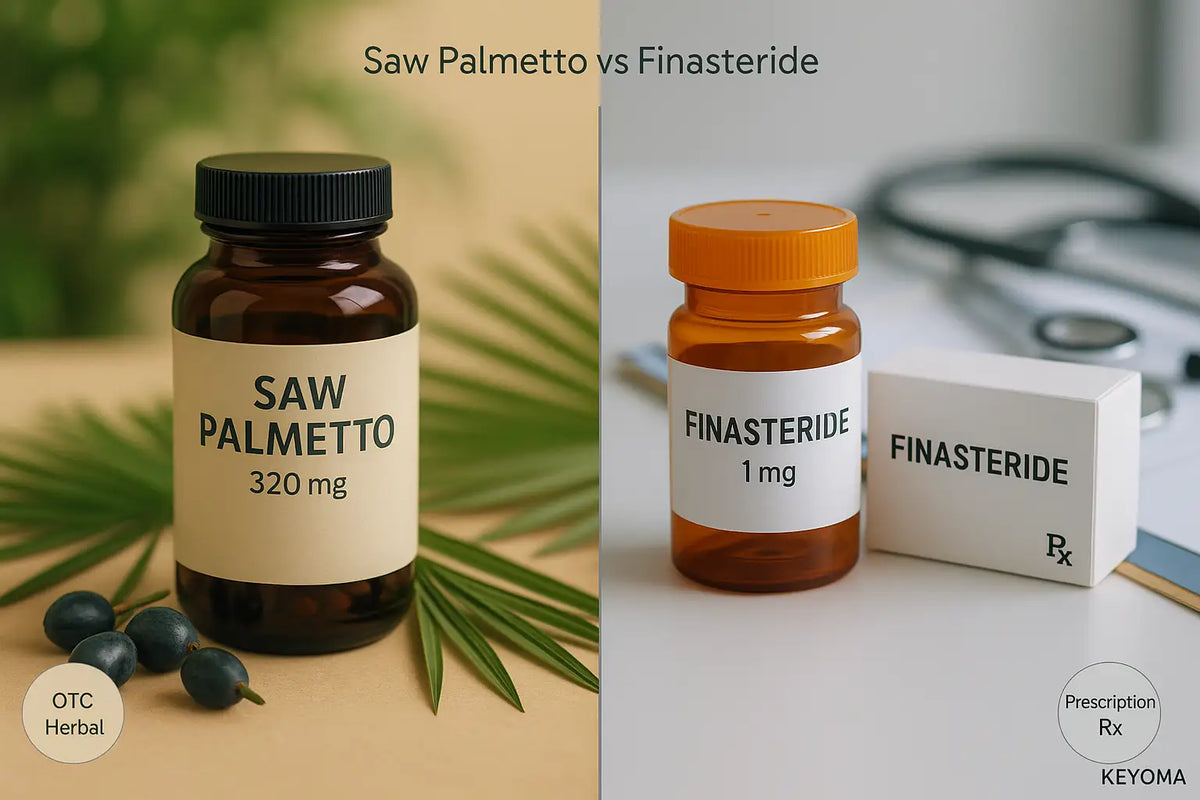In this article
If you are starting to research hair loss treatments or usually try natural options first, you might wonder about saw palmetto versus finasteride for hair loss.
Saw palmetto is an herbal supplement, and finasteride is a prescription medication, but the two have important similarities and differences. Although they act in related ways and both treat androgenetic alopecia (male pattern baldness), saw palmetto is not a natural “dupe” for finasteride.
Below, you will learn how each option works and whether saw palmetto or finasteride is more effective for hair loss.
Key Takeaways
-
Both treatments reduce DHT, and finasteride shows stronger evidence for androgenetic alopecia.
-
A 24-month trial found finasteride outperformed saw palmetto for hair growth.
-
Saw palmetto evidence remains limited and may help telogen effluvium or perceived thinning.
-
Finasteride works while taken, stopping returns hair toward baseline in about twelve months.
What Is Saw Palmetto?
Saw palmetto is a small palm plant found mostly in the southeastern United States. It is also called Serenoa repens.
In herbal medicine, saw palmetto extract comes from the plant’s fruit and seeds. People take it as capsules, tablets, or liquids, or use it topically. I found capsules easier to remember than liquid drops at night.

Saw Palmetto and Hair Loss Research
In some studies, saw palmetto seems to partly block DHT by inhibiting 5 alpha-reductase (5AR), the enzyme that turns testosterone into DHT.
Evidence on saw palmetto for hair loss is limited, though some exists. One meta-analysis of oral and topical forms reported 60 percent improved overall hair quality, 27 percent increased total hair count, and just over 83 percent greater density.
Saw palmetto has also been used as a diuretic, sedative, aphrodisiac, and nutritional tonic. It may also help treat or prevent bladder and urinary infections or prostate cancer. Even with these uses, there is not much long-term research focused on saw palmetto’s effects on hair loss.
How Does Saw Palmetto Work?
The dietary supplement is sometimes used to treat symptoms of an enlarged prostate gland, called benign prostatic hyperplasia (BPH). It appears to have an anti-inflammatory effect on the prostate that can reduce its size.
BPH is endocrinologically similar to androgenetic alopecia because both relate to hormones. More specifically, both are linked to excess DHT.
Much of the reason saw palmetto is thought to help hair is tied to these effects on BPH.
What Is Finasteride?
The best-known DHT blocker is finasteride, the prescription medication and active ingredient in Propecia. It is available in oral and topical forms.
We offer both oral finasteride (a pill) and topical finasteride & minoxidil spray (we will discuss that specific combination of hair loss ingredients shortly).
Finasteride is FDA-approved to treat AGA in men at a daily 1-milligram dose.
A higher 5-milligram dose is approved only for BPH, and the larger amount is not more effective for hair loss. When used for BPH, the brand name is Proscar®.
Finasteride and Hair Loss Research
A 2019 study of 532 Japanese men evaluated 1 milligram of daily finasteride over 10 years. In that group, 99 percent had no worsening during treatment, 91 percent improved hair growth, and no significant adverse effects were reported.
Another 2012 study (also on Japanese men) found just over 87 percent experienced some degree of hair growth while using finasteride.
If you want to know what to expect with finasteride, review our guide to the typical finasteride results timeline.
How Does Finasteride Work?
Like saw palmetto, finasteride targets and blocks DHT. It is very effective for male pattern baldness, and, unlike saw palmetto, has substantial research behind it.
Another benefit is that its effectiveness does not seem to fade with time. In fact, it tends to work best when you stick with it.
For example, some research shows men with no visible change after a year often improved with continued use. It also seems to work best in men over 30 with more advanced AGA.
That said, finasteride only works while you use it, and stopping typically returns you to baseline within about 12 months.
According to the FDA, finasteride lowers DHT right away, but it takes around three months of daily use to see hair benefits.
Saw Palmetto vs. Finasteride: Which Works Best for Hair Loss?

While finasteride’s strong results against androgenetic alopecia are well documented by clinical trials, saw palmetto’s effectiveness in reducing hair loss is not yet firmly demonstrated.
One clinical trial on 100 male patients with androgenetic alopecia split participants into two groups. One took 320 mg of saw palmetto, while the other received 1 mg of finasteride.
After 24 months of daily treatment, 38% of the saw palmetto group showed increased growth, compared to 68% in the finasteride group. Finasteride also worked on both the frontal scalp and vertex, while saw palmetto seemed limited to the vertex.
Although finasteride clearly outperformed saw palmetto in that trial, there was no control group. Because of that, the study cannot say how effective saw palmetto was compared to placebo.
Given the current evidence, it is reasonable to say finasteride is superior to saw palmetto for treating androgenetic alopecia.
There is weak evidence that saw palmetto might influence telogen effluvium and self-perceived thinning, whereas finasteride does not treat telogen effluvium.
However, neither has proven effective for other hair conditions, such as alopecia areata or hair loss caused by common scalp conditions.
Choose Evidence-Based Care With Keyoma
Choose a plan you can keep and match it to your goals. If your priority is treating androgenetic alopecia, talk with your clinician about finasteride, since it has stronger evidence when used consistently. If you prefer a gentler start or cannot use prescriptions, consider saw palmetto with your clinician’s guidance and set clear expectations.
For ongoing guidance and practical routines, follow Keyoma’s blog for more hair care tips and our social media.
Featured Product
100% Pure Batana Oil + Rosemary









